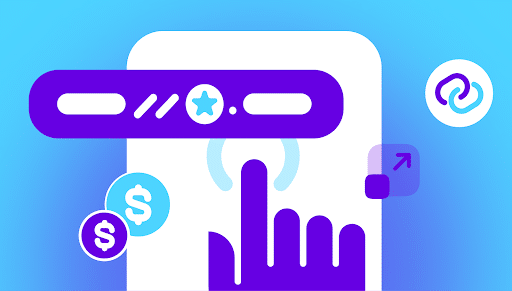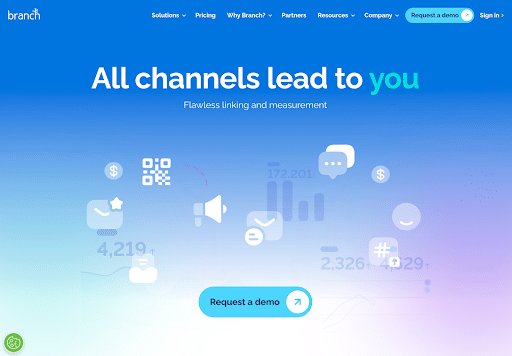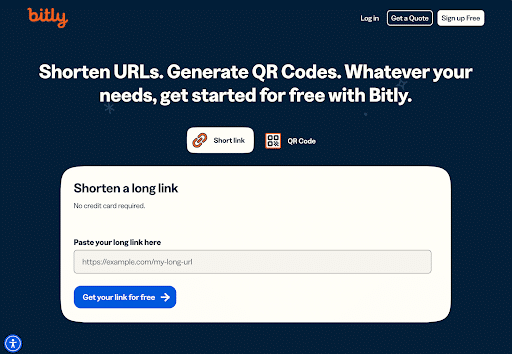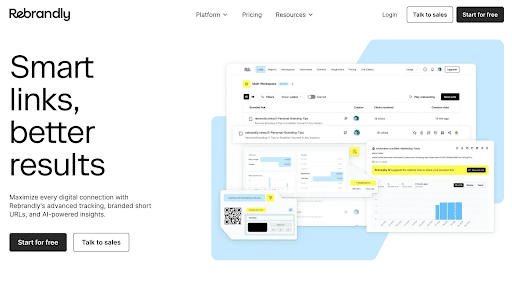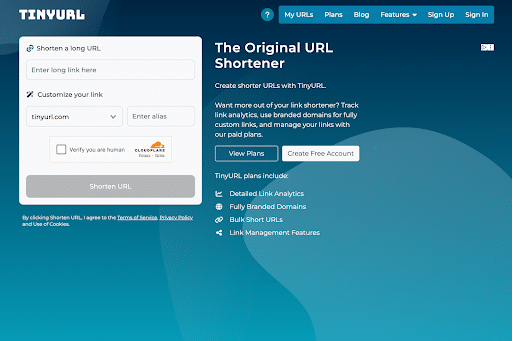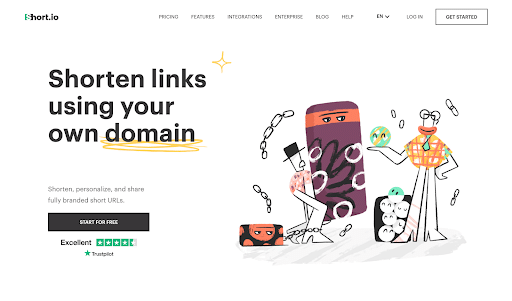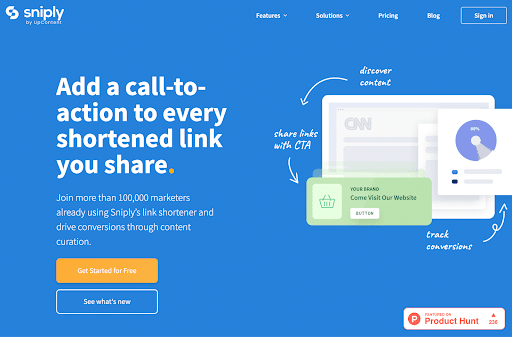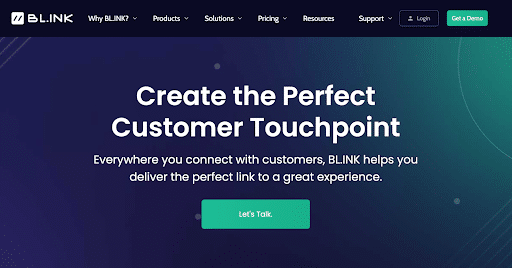Most marketing links never get clicked — often because they look messy, seem untrustworthy, or lack tracking. The right URL shortener fixes that and more.
Whether you’re running paid campaigns on TikTok, sending SMS promotions, or building organic engagement on social media, your links need to do more than just look clean — they need to perform.
In this guide, we’ll explain why URL shorteners matter for marketers, compare the key features, and provide a curated list of the top tools.
Why URL shorteners matter for growth
For modern marketers, a URL shortener is a foundational tool for boosting campaign performance, tracking effectiveness, and building brand trust across every platform, from social media posts to SMS campaigns.
Below, you’ll find several reasons why short links are a key part of the digital marketing stack.
1. Improving click-through rates (CTRs)
The visual impact of a link can influence whether someone clicks on it or scrolls past it. Clean, short links perform better than long, messy URLs, especially on character-limited platforms like social media posts.
Why? Short URLs are more user friendly, easier to read, and inspire brand trust. A branded, concise link can increase CTRs by making users feel more confident about where they’re headed.
Additionally, shorteners make it easier to share links across marketing channels — whether you embed them in Instagram bios, influencer stories, or email footers — without sacrificing professionalism or performance.
In short, the more user friendly your link appears, the more likely someone is to click.
2. Enabling campaign tracking
Marketers live and die by the data.
A good link shortener is as much about aesthetics as performance tracking. With the right tool, you can track link engagement across every channel and understand what’s driving real results.
By tagging your marketing campaigns and using unique short links per channel or audience segment, you can analyze the number of clicks, measure link clicks over time, and connect each one to a specific destination URL. Many modern tools offer detailed analytics dashboards to help you spot trends, optimize performance, and make faster decisions.
3. Building trust with branded links
Anyone can shorten a link. However, not everyone can do it in a way that builds brand equity and user trust.
Using branded links tied to a custom domain helps you control the first impression. Instead of a generic “short.ly/xyz,” you could use something like “go.yourbrand.com/spring-sale,” reinforcing your credibility while improving the user experience.
A branded domain tells users that the link is coming from you, not a third party. This minimizes drop-off and builds confidence — particularly important when promoting offers, running a referral program, or linking to gated content.
Branded shorteners also allow for custom URLs that include meaningful, descriptive slugs instead of random strings. If you’re trying to clean up a messy original URL, shortening it into a branded format can instantly elevate your brand presence.
Top marketing use cases for URL shorteners
URL shorteners are everywhere in marketing — because any place you need clean, trackable links, they shine. Here’s where they typically make an impact:
- Social media and influencer posts. Short, memorable links (especially branded ones) help drive more clicks and trust on platforms like TikTok, Instagram Stories, and Twitter/X.
- Email campaigns and newsletters. You can use short links to simplify tracking, avoid ugly long URLs, and monitor click behavior across audiences.
- SMS and chat messaging. With character limits and mobile-first readers, concise links work best — and tracking makes mobile campaigns measurable.
- QR (quick response) codes and print media. Embedding a short URL within a QR or printed code means no typos and better analytics from offline to online engagement.
- App marketing and deep linking. Smart links that route users seamlessly — web to app, or vice versa — help improve conversion and retention rates. This is where tools like Branch, with deep linking and attribution baked in, outperform basic shorteners.
- Paid ads and display campaigns. Shortened, branded links look more trustworthy in ads and enable attribution across search and display channels.
Four URL Shortener Features to Consider
Not all URL shorteners are created equal. While some offer the basics, others go far beyond link trimming, delivering the kind of functionality that supports campaign performance at scale. Whether you’re a solo marketer or managing a multichannel growth team, here are the core features to look for when evaluating a URL shortening service.
1. Analytics and reporting capabilities
If you’re operating without data, you’re falling behind. The best shorteners offer detailed analytics that show more than just a raw number of clicks. They also help you understand who is engaging with your links and where and how they’re engaging..
Look for tools that go beyond vanity metrics and offer reporting by device, location, referral source, and more. Granular analytics let you evaluate functionality, compare channels, and optimize campaigns faster. And if you’re investing in content and landing pages, good link data feeds your search engine optimization (SEO) strategy by showing which channels and formats drive actual traffic.
2. Branded links and custom domains
A strong brand doesn’t stop at your homepage. Shorteners that support branded links and custom domains allow you to extend that branding into every channel, whether you’re sharing on email, ads, or social media.
Want to go a step further? Look for platforms that let you use your domain as a branded domain so your links consistently reflect your identity. Many tools also allow you to create custom links with specific slugs for individual campaigns, giving you more control over user perception and messaging.
3. Integration with marketing tools
The real value of a shortener multiplies when it fits seamlessly into your existing workflows.
The best tools integrate with platforms like Zapier to enable automation across your tech stack, helping you shorten and distribute links automatically for blog posts, campaigns, or customer support.
You should also look for shorteners that work across SMS and chat tools, support video platforms like TikTok, and embed smoothly into your webpage builders or content management system (CMS). Whether using them in social media campaigns or powering a referral system, integration flexibility saves time and reduces errors.
4. Pricing, scalability, and support
URL shorteners come in all shapes and sizes — from basic free plans to enterprise-grade platforms with advanced features and support.
You should also evaluate each option’s pricing structure carefully.
Some may offer limited functionality on free tiers, while others bundle high-value features into paid plans that scale with your needs. If your team requires developer access, check for API availability and support for open source or self-hosted implementations.
Above all, consider the user experience and quality of support. Is onboarding intuitive? Can you get help when you need it? Tools that serve high-growth teams usually combine robust tech with responsive customer success.
Looking for more than basic link shortening? See how Branch supports smarter campaigns.
7 best URL shorteners for your brand
We’ve reviewed the most popular tools and narrowed them down to the seven best URL shorteners for marketers in 2025. Whether you’re looking for basic link shortening, branded link capabilities, or enterprise-grade analytics, there’s something here for every use case.
1. Branch
Alt. Text: Branch homepage showing cross-channel attribution dashboard (Source)
Branch offers a full suite of advanced features designed for growth teams that need more than basic link trimming. With cross-channel attribution, detailed analytics, and powerful custom links, Branch gives you a complete picture of how your links perform across paid, owned, and earned channels.
It’s particularly valuable for digital marketing teams that want to optimize campaigns based on real engagement, not just clicks. Branch also offers seamless deep linking, referral tracking, and post-click measurement, aiming to elevate the user experience with intelligent referral programs.
Ideal for: Growth marketers running paid user acquisition (UA) campaigns, product teams optimizing app user experience (UX), and performance marketers seeking full-funnel attribution.
2. Bitly
Alt. Text: A screenshot of Bitly’s homepage (Source)
A longtime player in the space, Bitly is one of the most well-known and widely used URL shorteners. It’s ideal for quick setup, especially if you want a free URL shortener with a generous feature set. Bitly supports branded links and has a user-friendly dashboard. Marketers and developers alike appreciate its robust API, which makes it easy to generate and manage custom URLs at scale.
Ideal for: Those looking for familiarity and ease of use.
3. Rebrandly
Alt. Text: A screenshot of Rebrandly’s homepage (Source)
Rebrandly stands out for marketers focused on brand consistency. It lets you create branded links using your custom domain, transforming even the ugliest URLs into clean, trustworthy ones.
The platform also supports branded domain configuration, meaning you can confidently share links that reflect your brand across ads, email, and social media. With built-in analytics to track link performance, Rebrandly is a great fit for campaigns where perception matters.
Ideal for: Brand-conscious marketers running paid or multichannel campaigns.
4. TinyURL
Alt. Text: A screenshot of TinyURL’s homepage (Source)
TinyURL still holds its own if you’re looking for a no-frills option. It’s perfect for quickly shortening links without needing an account or advanced features.
It’s especially helpful when you need to clean up a long URL for sharing in messages, QR codes, or printed materials. TinyURL also supports redirects and link expiration features, and it offers a free plan with simple analytics.
It’s not flashy — but it works.
Ideal for: Users who need quick, no-login link shortening for print, SMS, or QR codes.
| Feature | Branch | Other link shorteners |
|---|---|---|
| Branded links | Custom domain & branding | Limited or paid tiers only |
| Deep linking | Native mobile app support | Basic redirect functionality |
| Full-funnel attribution | Marketing analytics & retargeting | Limited to click tracking only |
| Campaign analytics | Cross-channel dashboards | Minimal to moderate detail |
| Platform integrations | Robust SDKs & API support | Varies, often lightweight or missing |
5. Short.io
Alt. Text: A screenshot of Short.io’s homepage (Source)
Short.io is a lesser-known but powerful tool that allows you to connect your own domain, manage branded links, and set up innovative routing features.
It supports custom slugs and has a useful API, making it a solid choice for dev-savvy marketers or teams that want more control. With strong workflow support and integrations, it’s also well suited for growing companies that want to automate their link ops.
Ideal for: Growth teams, marketers with dev resources, or power users needing workflow automation.
6. Sniply
Alt. Text: A screenshot of Sniply’s homepage (Source)
Sniply is built for engagement. Unlike traditional shorteners, it lets you share links with a customizable call-to-action overlay on the destination page.
It’s great for social media managers or creators who want to drive conversions from curated content. Its interface is clean and user friendly, and the link editor gives marketers a creative edge. So if you want to turn third-party links into engagement tools, Sniply delivers.
Ideal for: Social media managers and creators who curate third-party content and want to drive conversions.
7. BL.INK
Alt. Text: A screenshot of BL.INK’s homepage (Source)
BL.INK is designed for teams managing large-scale marketing campaigns. With detailed analytics, branded links, and customizable dashboards, it’s a favorite among enterprise customers. The platform offers advanced features like role-based permissions, real-time reporting, and extensive link management. It also integrates easily with tools like Zapier, making it a flexible option for teams needing power and scale.
Ideal for: Enterprise marketing teams with large-scale campaign needs and deep analytics requirements.
How to choose the right URL shortener
With so many options on the market, it’s easy to get overwhelmed by features and pricing pages. But choosing the best URL shortener for your needs involves aligning the tool with your marketing goals, budget, and data strategy.
Here’s how to make the right call.
Match features to your marketing goals
Start by evaluating each platform’s functionality and how well it matches your goals. Are you looking to optimize cross-channel performance? Do you need short links that plug into your digital marketing workflows? Are you running a referral program that requires tracking users from click to conversion?
If the answer is yes to any of those, then your tool needs more than basic shortening. It should help you track links across multiple platforms, channels, and customer journeys — ideally with analytics beyond simple click counts.
Factor in budget and scale
If you’re just getting started or only need a basic link shortener, you might be fine with a free plan. But if you’re part of a growing team, scaling fast, or want enterprise-level features like branded domains, referral tracking, and analytics, you’ll likely need a platform with flexible paid plans.
Consider how pricing aligns with your usage and how well the tool scales as your team or campaign complexity grows. If you’re working with developers or custom systems, make sure there’s a robust API available. For companies with specific security or hosting requirements, look for platforms that offer self-hosted or private cloud options.
A good platform should grow with you and not hold you back.
Look at analytics depth and integrations
Data is only valuable if you can access it. Look for tools that go beyond the raw number of clicks and offer detailed analytics about link performance, such as engagement by channel, geography, or device.
But data alone isn’t enough.
Consider how well the tool integrates into your current tech stack. Does it support automation through platforms like Zapier? Can it be used in SMS or push campaigns? Does it play well with video-driven platforms like TikTok? If you rely heavily on multi-touch campaigns, choose a shortener that integrates easily into your workflows and helps you act on insights — not just report them.
Why Branch is more than just a link shortener
While many tools on this list are great for shortening links, only Branch combines deep linking, cross-channel attribution, and enterprise-grade analytics in one platform. It’s perfect for marketers who want to connect every click to tangible business outcomes — not just track vanity metrics.
Deep linking across channels
Branch goes beyond basic short links, offering advanced features like deep linking that adapt across web, app, and device. Whether you’re sending users from email to app or running a complex referral program, Branch ensures a seamless user experience across channels that drives conversion.
It’s an ideal fit for digital marketing teams who need links that do more than just redirect — they need links that intelligently route, retain context, and convert.
Post-click attribution and analytics
Branch helps you manage every link with precision. The built-in link management system pairs with detailed analytics to show what happens after the click — not just that it happened.
You can track links across devices, analyze CTRs, and optimize your marketing campaigns using actionable post-click data. That’s attribution you can actually use, not just a spreadsheet of clicks.
What Branch customers are saying
Whether transforming a long URL to a short URL, preserving context in the original URL, or creating branded links for better engagement, top brands rely on Branch to enhance the user experience and drive results at scale.
For example, Funstage and Platogo use over 1 million deep links every month to drive player loyalty and retention. By implementing Branch’s cross-platform deep linking and attribution, the gaming companies were able to unify web and app experiences, making it effortless for users to reengage and pick up where they left off.
The result? A stickier product experience and a measurable lift in long-term engagement.
Similarly, Tunaiku, one of Southeast Asia’s leading lending apps, boosted app downloads by 23% after adopting Branch’s advanced attribution and linking tools. By moving beyond last-click models and gaining visibility into its full user journey, Tunaiku optimized acquisition campaigns, doubled down on high-performing channels, and scaled customer growth without wasted ad spend.
Ready to go beyond basic links? Branch turns every click into insight. Book a demo to see it in action.

